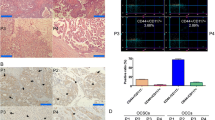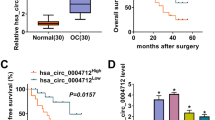Abstract
The aberrant expression of highly upregulated in liver cancer (HULC) has been reported to participate in ovarian cancer development. A recent research has revealed that HULC-modulated microRNAs (miRNAs) in tumorigenesis. To confirm the functions of HULC on tumorigenesis of ovarian, we explored the effects of HULC expression on ovarian cancer cell development, as well as the underlying mechanism. We transfected SKOV3 cells with pEX-HULC, sh-HULC, and miR-125a-3p mimic as well as their corresponding negative controls (pEX-3, sh-NC, and NC) to alter the expression of HULC and miR-125a-3p, which were analyzed by quantitative reverse transcription PCR (qRT-PCR). Expression of proteins associated with cell cycle, apoptosis, and signaling pathways was determined by Western blot assay. The proliferation, apoptosis, migration, and invasion were explored by bromodeoxyuridine (BrdU) incorporation assay, Annexin V-fluorescein isothiocyanate (FITC)/propidium iodide (PI) method, and transwell migration and invasion assays, respectively. HULC overexpression promoted proliferation, migration, and invasion, while inhibited apoptosis of SKOV3 cells. In addition, HULC negatively regulated the expression of miR-125a-3p. Besides, miR-125a-3p mimic reversed the effects of HULC on proliferation, migration, and invasion as well as apoptosis of SKOV3 cells. Moreover, we found that HULC enhanced phosphorylated expression of regulatory factors in phosphatidylinositol 3 kinase/protein kinase B/mammalian targets of rapamycin (PI3K/AKT/mTOR) signaling pathway by downregulating expression of miR-125a-3p. Overexpression of HULC promoted ovarian carcinoma development by activating PI3K/AKT/mTOR signaling pathway via downregulating miR-125a-3p.






Similar content being viewed by others
Change history
01 March 2022
This article has been retracted. Please see the Retraction Notice for more detail: https://doi.org/10.1007/s13105-022-00883-8
19 March 2021
An Editorial Expression of Concern to this paper has been published: https://doi.org/10.1007/s13105-021-00805-0
References
Bray F, Ferlay J, Soerjomataram I, Siegel RL, Torre LA, Jemal A (2018) Global cancer statistics 2018: GLOBOCAN estimates of incidence and mortality worldwide for 36 cancers in 185 countries. CA Cancer J Clin 68:394–424. https://doi.org/10.3322/caac.21492
Chen S, Wu DD, Sang XB, Wang LL, Zong ZH, Sun KX, Liu BL, Zhao Y (2017) The lncRNA HULC functions as an oncogene by targeting ATG7 and ITGB1 in epithelial ovarian carcinoma. Cell Death Dis 8:e3118. https://doi.org/10.1038/cddis.2017.486
Cui M, Xiao Z, Wang Y, Zheng M, Song T, Cai X, Sun B, Ye L, Zhang X (2015) Long noncoding RNA HULC modulates abnormal lipid metabolism in hepatoma cells through an miR-9-mediated RXRA signaling pathway. Cancer Res 75:846–857. https://doi.org/10.1158/0008-5472.can-14-1192
Gao N, Flynn DC, Zhang Z, Zhong XS, Walker V, Liu KJ, Shi X, Jiang BH (2004) G1 cell cycle progression and the expression of G1 cyclins are regulated by PI3K/AKT/mTOR/p70S6K1 signaling in human ovarian cancer cells. Am J Physiol Cell Physiol 287:C281–C291. https://doi.org/10.1152/ajpcell.00422.2003
Gao Y, Meng H, Liu S, Hu J, Zhang Y, Jiao T, Liu Y, Ou J, Wang D, Yao L, Liu S, Hui N (2015) LncRNA-HOST2 regulates cell biological behaviors in epithelial ovarian cancer through a mechanism involving microRNA let-7b. Hum Mol Genet 24:841–852. https://doi.org/10.1093/hmg/ddu502
Hakem R, Hakem A, Duncan GS, Henderson JT, Woo M, Soengas MS, Elia A, de la Pompa JL, Kagi D, Khoo W, Potter J, Yoshida R, Kaufman SA, Lowe SW, Penninger JM, Mak TW (1998) Differential requirement for caspase 9 in apoptotic pathways in vivo. Cell 94:339–352
Hashiguchi Y, Nishida N, Mimori K, Sudo T, Tanaka F, Shibata K, Ishii H, Mochizuki H, Hase K, Doki Y, Mori M (2012) Down-regulation of miR-125a-3p in human gastric cancer and its clinicopathological significance. Int J Oncol 40:1477–1482. https://doi.org/10.3892/ijo.2012.1363
Hockenbery D, Nunez G, Milliman C, Schreiber RD, Korsmeyer SJ (1990) Bcl-2 is an inner mitochondrial membrane protein that blocks programmed cell death. Nature 348:334–336. https://doi.org/10.1038/348334a0
Jiang L, Huang Q, Zhang S, Zhang Q, Chang J, Qiu X, Wang E (2010) Hsa-miR-125a-3p and hsa-miR-125a-5p are downregulated in non-small cell lung cancer and have inverse effects on invasion and migration of lung cancer cells. BMC Cancer 10:318. https://doi.org/10.1186/1471-2407-10-318
Jones BA, Varambally S, Arend RC (2018) Histone methyltransferase EZH2: a therapeutic target for ovarian cancer. Mol Cancer Ther 17:591–602. https://doi.org/10.1158/1535-7163.mct-17-0437
Kong D, Wang Y (2018) Knockdown of lncRNA HULC inhibits proliferation, migration, invasion, and promotes apoptosis by sponging miR-122 in osteosarcoma. J Cell Biochem 119:1050–1061. https://doi.org/10.1002/jcb.26273
Lee M, Kim EJ, Jeon MJ (2016) MicroRNAs 125a and 125b inhibit ovarian cancer cells through post-transcriptional inactivation of EIF4EBP1. Oncotarget 7:8726–8742. https://doi.org/10.18632/oncotarget.6474
Li SP, Xu HX, Yu Y, He JD, Wang Z, Xu YJ, Wang CY, Zhang HM, Zhang RX, Zhang JJ, Yao Z, Shen ZY (2016) LncRNA HULC enhances epithelial-mesenchymal transition to promote tumorigenesis and metastasis of hepatocellular carcinoma via the miR-200a-3p/ZEB1 signaling pathway. Oncotarget 7:42431–42446. https://doi.org/10.18632/oncotarget.9883
Liang L, Gao C, Li Y, Sun M, Xu J, Li H, Jia L, Zhao Y (2017) miR-125a-3p/FUT5-FUT6 axis mediates colorectal cancer cell proliferation, migration, invasion and pathological angiogenesis via PI3K-Akt pathway. Cell Death Dis 8:e2968. https://doi.org/10.1038/cddis.2017.352
Livak KJ, Schmittgen TD (2001) Analysis of relative gene expression data using real-time quantitative PCR and the 2(−Delta Delta C(T)) method. Methods 25:402–408. https://doi.org/10.1006/meth.2001.1262
Liz J, Esteller M (2016) lncRNAs and microRNAs with a role in cancer development. Biochim Biophys Acta 1859:169–176. https://doi.org/10.1016/j.bbagrm.2015.06.015
Ma MZ, Chu BF, Zhang Y, Weng MZ, Qin YY, Gong W, Quan ZW (2015) Long non-coding RNA CCAT1 promotes gallbladder cancer development via negative modulation of miRNA-218-5p. Cell Death Dis 6:e1583. https://doi.org/10.1038/cddis.2014.541
Mabuchi S, Kuroda H, Takahashi R, Sasano T (2015) The PI3K/AKT/mTOR pathway as a therapeutic target in ovarian cancer. Gynecol Oncol 137:173–179. https://doi.org/10.1016/j.ygyno.2015.02.003
Mathieu KB, Bedi DG, Thrower SL, Qayyum A, Bast RC Jr (2018) Screening for ovarian cancer: imaging challenges and opportunities for improvement. Ultrasound Obstet Gynecol 51:293–303. https://doi.org/10.1002/uog.17557
Ninio-Many L, Grossman H, Levi M, Zilber S, Tsarfaty I, Shomron N, Tuvar A, Chuderland D, Stemmer SM, Ben-Aharon I, Shalgi R (2014) MicroRNA miR-125a-3p modulates molecular pathway of motility and migration in prostate cancer cells. Oncoscience 1:250–261
Panzitt K, Tschernatsch MM, Guelly C, Moustafa T, Stradner M, Strohmaier HM, Buck CR, Denk H, Schroeder R, Trauner M, Zatloukal K (2007) Characterization of HULC, a novel gene with striking up-regulation in hepatocellular carcinoma, as noncoding RNA. Gastroenterology 132:330–342. https://doi.org/10.1053/j.gastro.2006.08.026
Porter AG, Janicke RU (1999) Emerging roles of caspase-3 in apoptosis. Cell Death Differ 6:99–104. https://doi.org/10.1038/sj.cdd.4400476
Stacey DW (2003) Cyclin D1 serves as a cell cycle regulatory switch in actively proliferating cells. Curr Opin Cell Biol 15:158–163
Tang H, Li RP, Liang P, Zhou YL, Wang GW (2015) miR-125a inhibits the migration and invasion of liver cancer cells via suppression of the PI3K/AKT/mTOR signaling pathway. Oncol Lett 10:681–686. https://doi.org/10.3892/ol.2015.3264
Uzan VR, Lengert A, Boldrini E, Penna V, Scapulatempo-Neto C, Scrideli CA, Filho AP, Cavalcante CE, de Oliveira CZ, Lopes LF, Vidal DO (2016) High expression of HULC is associated with poor prognosis in osteosarcoma patients. PLoS One 11:e0156774. https://doi.org/10.1371/journal.pone.0156774
Wang J, Yan F, Zhao Q, Zhan F, Wang R, Wang L, Zhang Y, Huang X (2017) Circulating exosomal miR-125a-3p as a novel biomarker for early-stage colon cancer. Sci Rep 7:4150. https://doi.org/10.1038/s41598-017-04386-1
Wang Y, Chen F, Zhao M, Yang Z, Li J, Zhang S, Zhang W, Ye L, Zhang X (2017) The long noncoding RNA HULC promotes liver cancer by increasing the expression of the HMGA2 oncogene via sequestration of the microRNA-186. J Biol Chem 292:15395–15407. https://doi.org/10.1074/jbc.M117.783738
Xiong Y, Hannon GJ, Zhang H, Casso D, Kobayashi R, Beach D (1993) p21 is a universal inhibitor of cyclin kinases. Nature 366:701–704. https://doi.org/10.1038/366701a0
Yao R, Cooper GM (1995) Requirement for phosphatidylinositol-3 kinase in the prevention of apoptosis by nerve growth factor. Science 267:2003–2006
Yin F, Zhang JN, Wang SW, Zhou CH, Zhao MM, Fan WH, Fan M, Liu S (2015) MiR-125a-3p regulates glioma apoptosis and invasion by regulating Nrg1. PLoS One 10:e0116759. https://doi.org/10.1371/journal.pone.0116759
Zhang Z, Cheng J, Wu Y, Qiu J, Sun Y, Tong X (2016) LncRNA HOTAIR controls the expression of Rab22a by sponging miR-373 in ovarian cancer. Mol Med Rep 14:2465–2472. https://doi.org/10.3892/mmr.2016.5572
Zhao Y, Guo Q, Chen J, Hu J, Wang S, Sun Y (2014) Role of long non-coding RNA HULC in cell proliferation, apoptosis and tumor metastasis of gastric cancer: a clinical and in vitro investigation. Oncol Rep 31:358–364. https://doi.org/10.3892/or.2013.2850
Zhu Y, Zhang X, Qi L, Cai Y, Yang P, Xuan G, Jiang Y (2016) HULC long noncoding RNA silencing suppresses angiogenesis by regulating ESM-1 via the PI3K/Akt/mTOR signaling pathway in human gliomas. Oncotarget 7:14429–14440. https://doi.org/10.18632/oncotarget.7418
Author information
Authors and Affiliations
Corresponding author
Ethics declarations
Conflict of interest
The authors declare that they have no conflict of interest.
Additional information
Publisher’s note
Springer Nature remains neutral with regard to jurisdictional claims in published maps and institutional affiliations.
Highlights
1. HULC negatively mediates miR-125a-3p expression in ovarian carcinoma cells SKOV3.
2. HULC overexpression promotes ovarian carcinoma development by downregulating miR-125a-3p in SKOV3 cells.
3. Upregulated miR-125a-3p blocks PI3K/AKT/mTOR pathway activated by HULC overexpression.
This article has been retracted. Please see the retraction notice for more detail: https://doi.org/10.1007/s13105-022-00883-8
About this article
Cite this article
Chu, P., Xu, L. & Su, H. RETRACTED ARTICLE: HULC functions as an oncogene in ovarian carcinoma cells by negatively modulating miR-125a-3p. J Physiol Biochem 75, 163–171 (2019). https://doi.org/10.1007/s13105-019-00669-5
Received:
Accepted:
Published:
Issue Date:
DOI: https://doi.org/10.1007/s13105-019-00669-5




